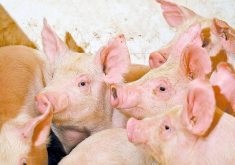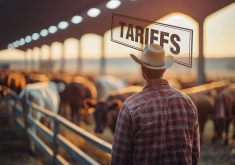The draft Code of Practice for the Care and Handling of Pigs is now in its public comment period, which ends Aug. 3, and can be viewed at www.nfacc.ca. Its publication has been delayed due to disagreement over some of the sensitive issues that were identified as priorities by the Pig Scientific Committee members. These areas are controlling pain from castration, methods of euthanasia, space allowances for growing pigs and sows, sow-housing systems and social management of sows. In addition, the new codes cover housing, feeding, health, husbandry practices and transportation.
Read Also

Horns aren’t unlocking anytime soon on livestock transport standards
Standards good enough meet the definition of “humane” animal transportation still vary widely between what what industry wants, what animal rights advocates want and, between the two, what federal regulators decide is good enough.
It should be recognized that balancing the views and opinions of people representing all sectors of the industry as well as animal welfare organizations is a nigh-on impossible task. This is noted in the introduction to the document, which says, “As the code development process involved representatives with diverse interests, not all parties fully agree with every requirement and recommendation. However, all members agree that this document represents the best achievable balance.”
This compromise between divergent interests gives the new codes strength and validity. If all the parties agree that this is the way forward, then it effectively allows the industry to defend itself against extreme animal rights organizations and also allows retailers to stand behind the codes in response to consumer questions about pig welfare.
Differences from 1993
The biggest difference from the previous codes of practice, published in 1993, is that the new document lists “requirements” and “recommendations,” whereas the 1993 code only listed recommendations. This is partly because the codes will form the basis of a revised Animal Care Assessment Model, which will be designed to demonstrate that the codes are being followed and which will be part of the industry’s quality assurance (CQA) program. Without requirements, this would be toothless.
The 62-page document has a well-structured and logical organization and is well written, although I do have some criticism of the emphasis placed on particular areas. My main question is whether too much emphasis has been put on the priority areas, which arise both from public concern and a scientific review, and not enough on defining best-practice management. As a production consultant, the areas I see as being most likely to be involved in compromised welfare include:
- Rapid recognition of sick, injured or disadvantaged pigs;
- Appropriate treatment of sick or injured pigs;
- Quality of hospital pens and their management;
- Ability to carry out welfare-sensitive tasks such as injecting, teeth clipping, castration etc. correctly;
- Identification of pigs requiring euthanasia and correct euthanasia technique;
- Moving and handling pigs.
Of course these areas are covered in the codes, but I see the opportunity to improve on them more than the draft code requires because we know how to make improvements through best management practice (BMP). In these key husbandry areas, more of the recommendations in the draft could be requirements, as they are in European legislation.
Stockpersons’ knowledge
The draft codes recognize the importance of the stockperson’s knowledge and skills, and their impact on welfare, far more than the existing codes. However, the requirement for staff to be competent in key areas which impact welfare is limited. For example, in the section that deals with sick and injured animals, there is a requirement for pigs to be inspected daily, for there to be a protocol relating to treatment of sick or injured pigs and that pigs are treated, sold or euthanized according to their condition.
It then gives a recommendation, not a requirement, that says, “Ensure all stockpersons are competent in recognizing behaviour associated with common pig diseases…” Rapid recognition and appropriate treatment of sick or injured pigs has such a big impact on welfare that it should be a requirement that staff are competent in this and the other areas I listed above. Having some sort of competency certification for stockpersons would not only go a long way to reassuring consumers on animal welfare standards, but would result in a genuine improvement in welfare on the farm.
Emergency management
One area that I believe is dealt with inadequately is the area of emergency management. Emergency events such as power failure or fire are fortunately rare, but they have the potential to compromise the welfare of large numbers of pigs and even result in extensive death. The section on “Emergency and Safety” commands a measly eight lines in the draft codes, and dealing with the failure of feed or water supply is relegated to the section on feed and water. There should be a requirement to have a written plan that deals with all potential emergency events and that staff should be required to be familiar with the plan and how to execute it, both of which are only recommendations in the document. This area needs strengthening and given more emphasis.
I have highlighted two examples where I believe that the codes need strengthening and there are a number of other areas where I feel that changes should be made. I will be submitting my detailed comments to the National Farm Animal Care Council and I encourage producers and others in the industry to review the draft codes and also submit comments. Most of the codes are common sense and good husbandry which will be supported by the production sector. It is inevitable that there are some compromises but, when a consensus is reached, we will have a set of standards that will define and defend the industry’s welfare standards for the foreseeable future.
In my next article, I will be examining the more sensitive areas of the draft codes, notably sow housing and space allowances.














